Provide Management Accounting Information: Assessment Workbook W
VerifiedAdded on 2020/04/21
|44
|8213
|100
Homework Assignment
AI Summary
This assessment workbook addresses the unit of competency FNSACC507, focusing on providing management accounting information. The workbook includes a variety of questions and exercises covering key concepts such as the three main functions of management, differences in cost accounting systems between manufacturing and service organizations, the distinction between cost and cost drivers, and the calculation of costs and markups. It also delves into the management and safeguarding of inventory and materials, including system procedures for storage, purchasing, and stock issuance. The assessment includes written questions, exercises, and a case study designed to test the student's understanding of these concepts and their ability to apply them to real-world scenarios. The workbook provides detailed solutions and calculations related to financial statements and inventory management. The student demonstrates an understanding of cost accounting principles, financial analysis, and inventory management practices.
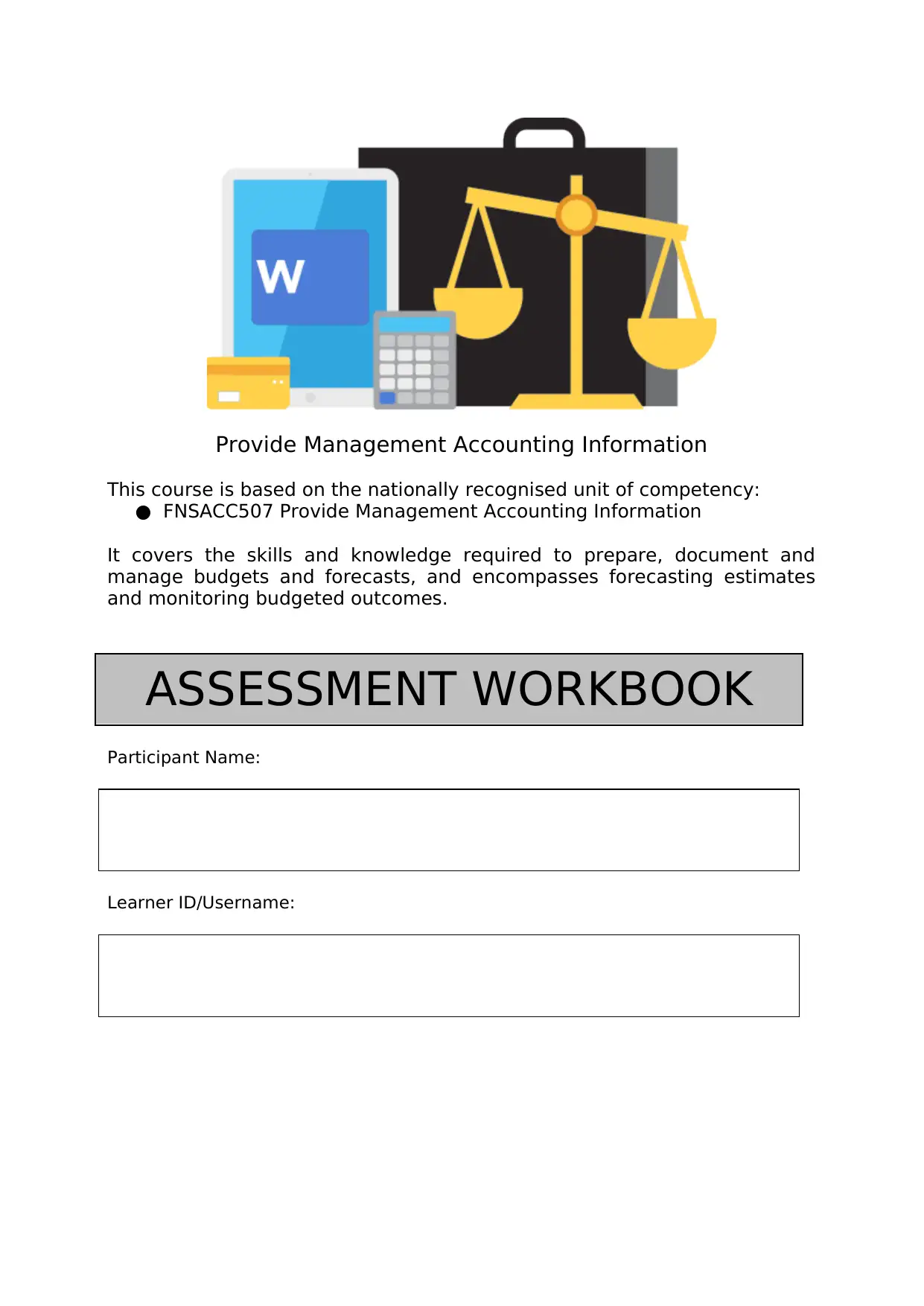
Provide Management Accounting Information
This course is based on the nationally recognised unit of competency:
● FNSACC507 Provide Management Accounting Information
It covers the skills and knowledge required to prepare, document and
manage budgets and forecasts, and encompasses forecasting estimates
and monitoring budgeted outcomes.
ASSESSMENT WORKBOOK
Participant Name:
Learner ID/Username:
This course is based on the nationally recognised unit of competency:
● FNSACC507 Provide Management Accounting Information
It covers the skills and knowledge required to prepare, document and
manage budgets and forecasts, and encompasses forecasting estimates
and monitoring budgeted outcomes.
ASSESSMENT WORKBOOK
Participant Name:
Learner ID/Username:
Paraphrase This Document
Need a fresh take? Get an instant paraphrase of this document with our AI Paraphraser
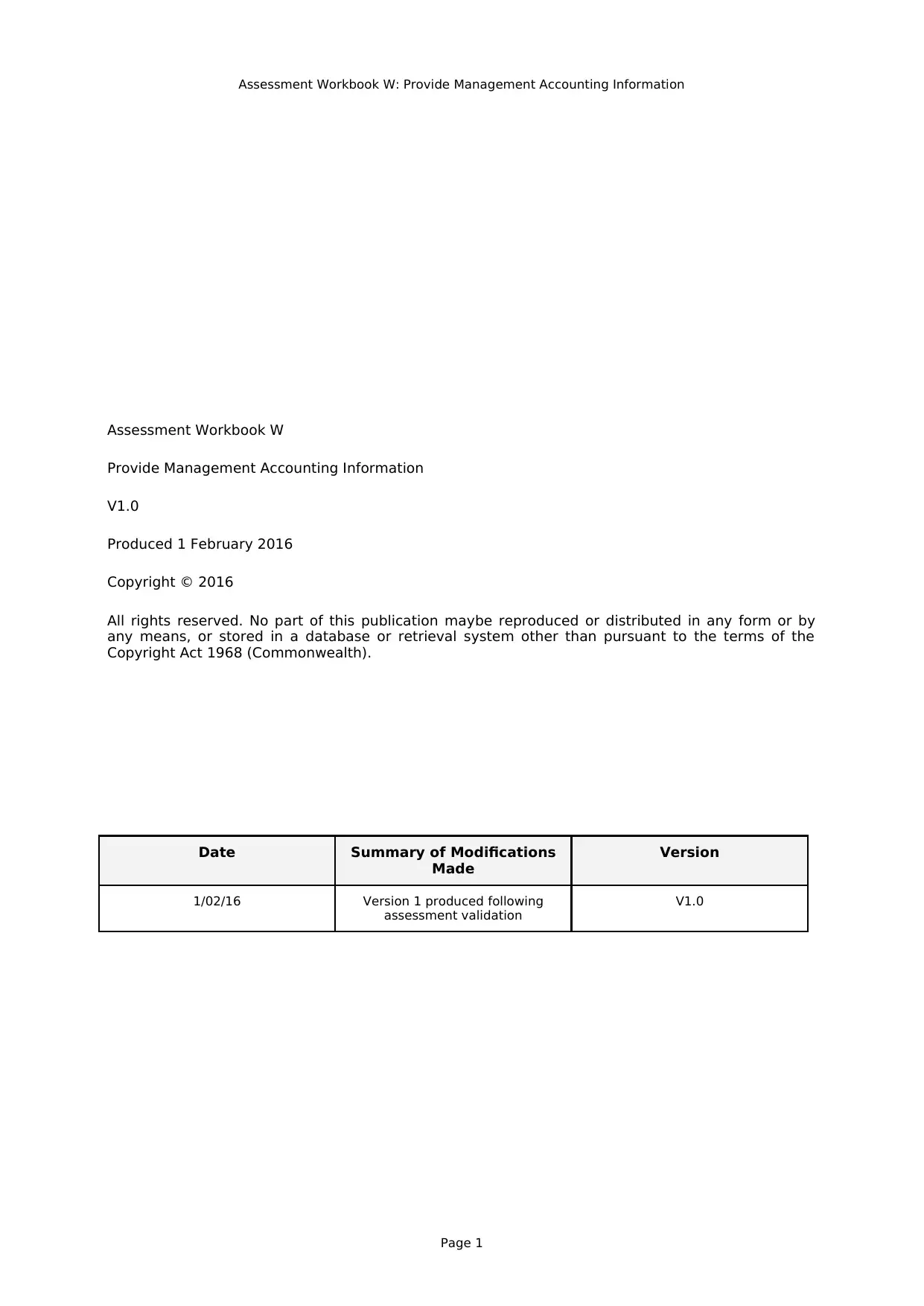
Assessment Workbook W: Provide Management Accounting Information
Assessment Workbook W
Provide Management Accounting Information
V1.0
Produced 1 February 2016
Copyright © 2016
All rights reserved. No part of this publication maybe reproduced or distributed in any form or by
any means, or stored in a database or retrieval system other than pursuant to the terms of the
Copyright Act 1968 (Commonwealth).
Date Summary of Modifications
Made
Version
1/02/16 Version 1 produced following
assessment validation
V1.0
Page 1
Assessment Workbook W
Provide Management Accounting Information
V1.0
Produced 1 February 2016
Copyright © 2016
All rights reserved. No part of this publication maybe reproduced or distributed in any form or by
any means, or stored in a database or retrieval system other than pursuant to the terms of the
Copyright Act 1968 (Commonwealth).
Date Summary of Modifications
Made
Version
1/02/16 Version 1 produced following
assessment validation
V1.0
Page 1
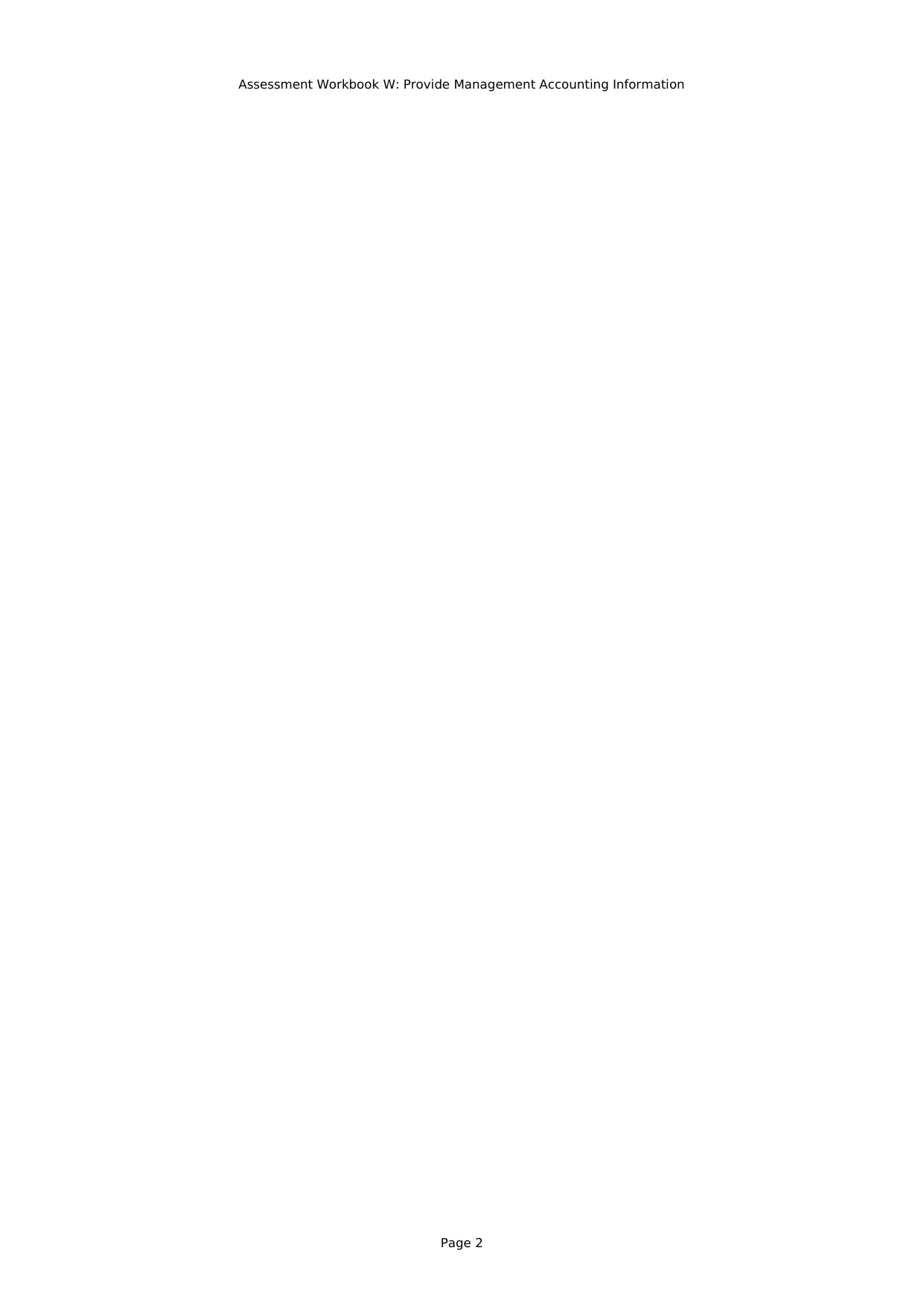
Assessment Workbook W: Provide Management Accounting Information
Page 2
Page 2
⊘ This is a preview!⊘
Do you want full access?
Subscribe today to unlock all pages.

Trusted by 1+ million students worldwide
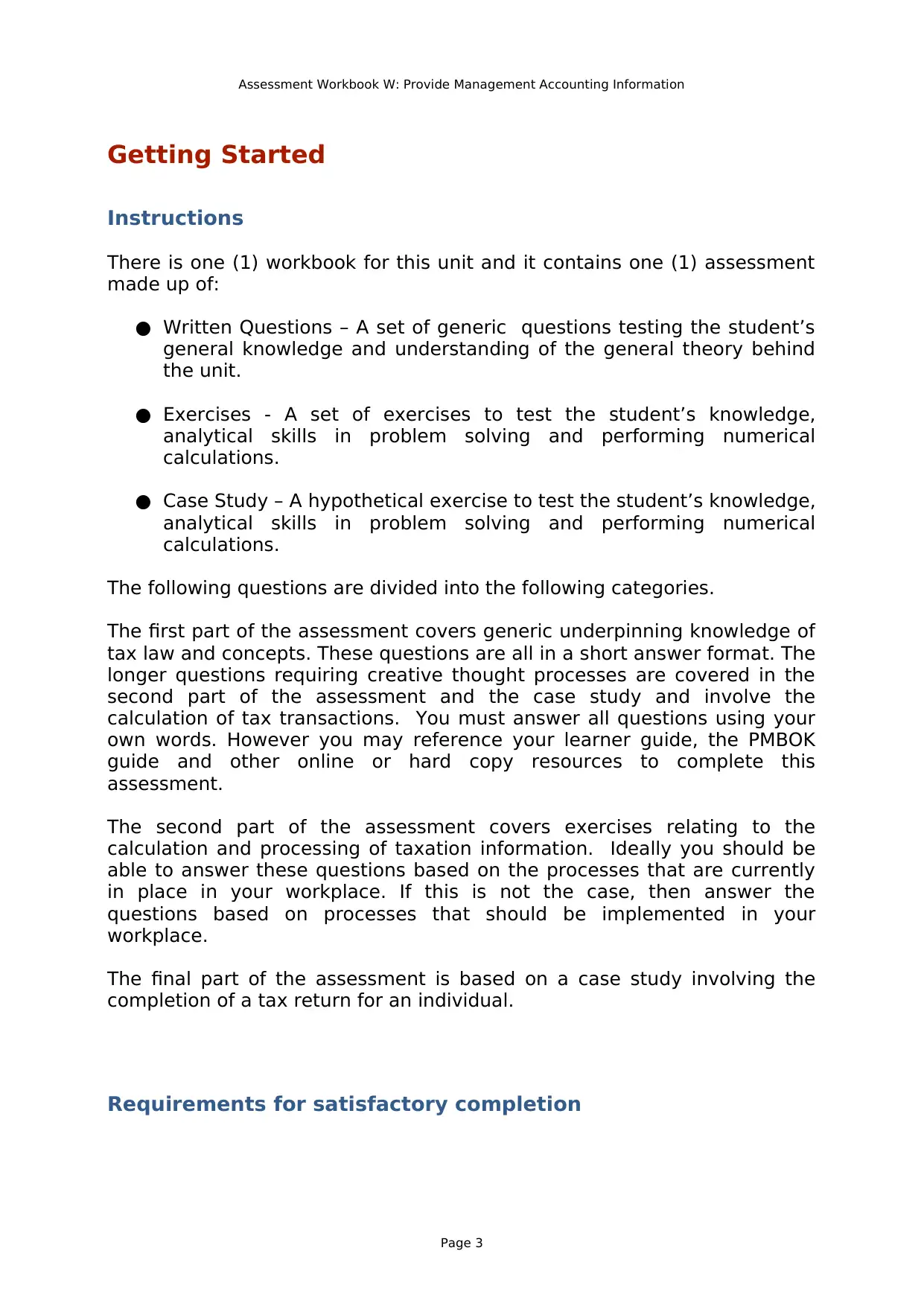
Assessment Workbook W: Provide Management Accounting Information
Getting Started
Instructions
There is one (1) workbook for this unit and it contains one (1) assessment
made up of:
● Written Questions – A set of generic questions testing the student’s
general knowledge and understanding of the general theory behind
the unit.
● Exercises - A set of exercises to test the student’s knowledge,
analytical skills in problem solving and performing numerical
calculations.
● Case Study – A hypothetical exercise to test the student’s knowledge,
analytical skills in problem solving and performing numerical
calculations.
The following questions are divided into the following categories.
The first part of the assessment covers generic underpinning knowledge of
tax law and concepts. These questions are all in a short answer format. The
longer questions requiring creative thought processes are covered in the
second part of the assessment and the case study and involve the
calculation of tax transactions. You must answer all questions using your
own words. However you may reference your learner guide, the PMBOK
guide and other online or hard copy resources to complete this
assessment.
The second part of the assessment covers exercises relating to the
calculation and processing of taxation information. Ideally you should be
able to answer these questions based on the processes that are currently
in place in your workplace. If this is not the case, then answer the
questions based on processes that should be implemented in your
workplace.
The final part of the assessment is based on a case study involving the
completion of a tax return for an individual.
Requirements for satisfactory completion
Page 3
Getting Started
Instructions
There is one (1) workbook for this unit and it contains one (1) assessment
made up of:
● Written Questions – A set of generic questions testing the student’s
general knowledge and understanding of the general theory behind
the unit.
● Exercises - A set of exercises to test the student’s knowledge,
analytical skills in problem solving and performing numerical
calculations.
● Case Study – A hypothetical exercise to test the student’s knowledge,
analytical skills in problem solving and performing numerical
calculations.
The following questions are divided into the following categories.
The first part of the assessment covers generic underpinning knowledge of
tax law and concepts. These questions are all in a short answer format. The
longer questions requiring creative thought processes are covered in the
second part of the assessment and the case study and involve the
calculation of tax transactions. You must answer all questions using your
own words. However you may reference your learner guide, the PMBOK
guide and other online or hard copy resources to complete this
assessment.
The second part of the assessment covers exercises relating to the
calculation and processing of taxation information. Ideally you should be
able to answer these questions based on the processes that are currently
in place in your workplace. If this is not the case, then answer the
questions based on processes that should be implemented in your
workplace.
The final part of the assessment is based on a case study involving the
completion of a tax return for an individual.
Requirements for satisfactory completion
Page 3
Paraphrase This Document
Need a fresh take? Get an instant paraphrase of this document with our AI Paraphraser
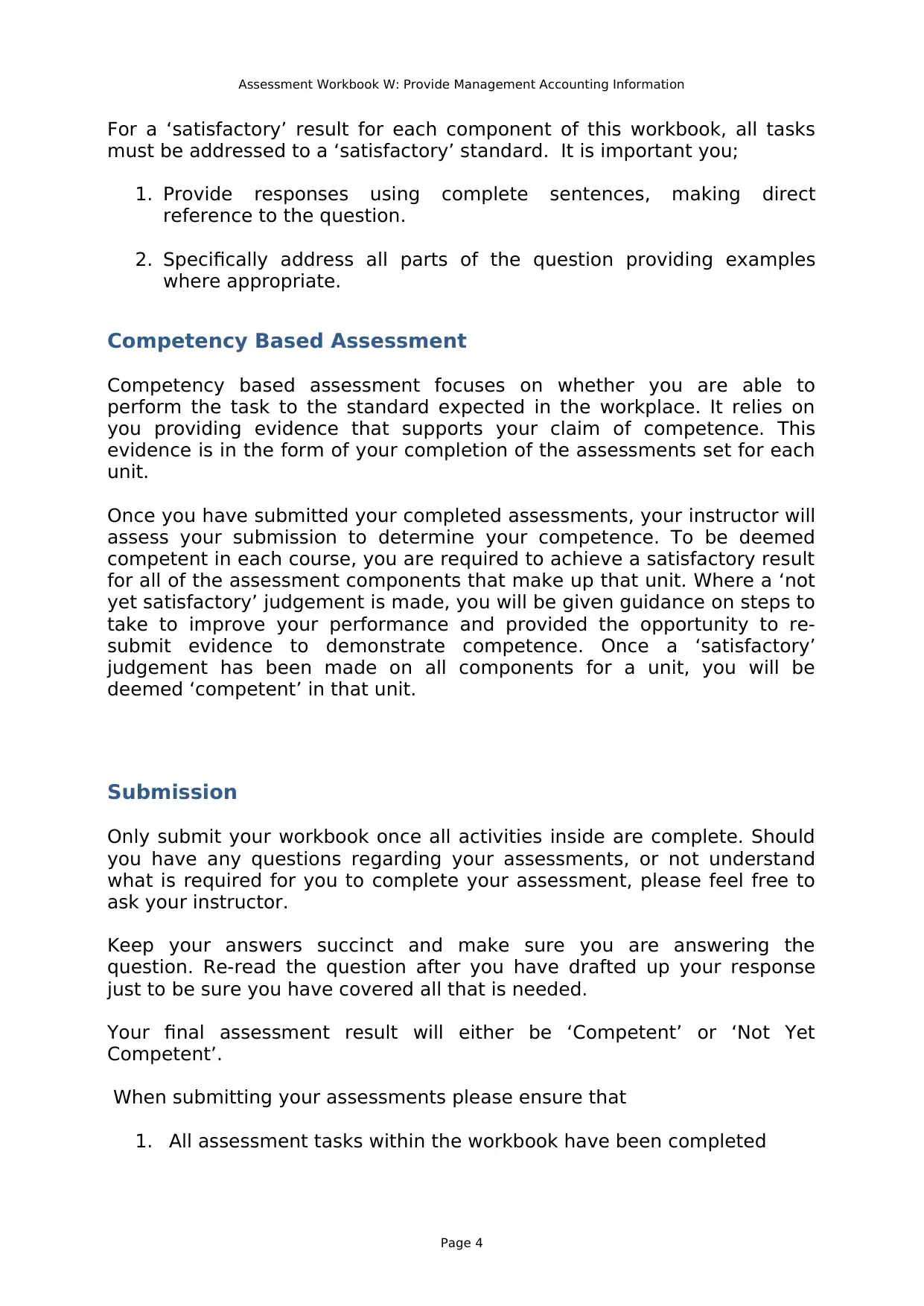
Assessment Workbook W: Provide Management Accounting Information
For a ‘satisfactory’ result for each component of this workbook, all tasks
must be addressed to a ‘satisfactory’ standard. It is important you;
1. Provide responses using complete sentences, making direct
reference to the question.
2. Specifically address all parts of the question providing examples
where appropriate.
Competency Based Assessment
Competency based assessment focuses on whether you are able to
perform the task to the standard expected in the workplace. It relies on
you providing evidence that supports your claim of competence. This
evidence is in the form of your completion of the assessments set for each
unit.
Once you have submitted your completed assessments, your instructor will
assess your submission to determine your competence. To be deemed
competent in each course, you are required to achieve a satisfactory result
for all of the assessment components that make up that unit. Where a ‘not
yet satisfactory’ judgement is made, you will be given guidance on steps to
take to improve your performance and provided the opportunity to re-
submit evidence to demonstrate competence. Once a ‘satisfactory’
judgement has been made on all components for a unit, you will be
deemed ‘competent’ in that unit.
Submission
Only submit your workbook once all activities inside are complete. Should
you have any questions regarding your assessments, or not understand
what is required for you to complete your assessment, please feel free to
ask your instructor.
Keep your answers succinct and make sure you are answering the
question. Re-read the question after you have drafted up your response
just to be sure you have covered all that is needed.
Your final assessment result will either be ‘Competent’ or ‘Not Yet
Competent’.
When submitting your assessments please ensure that
1. All assessment tasks within the workbook have been completed
Page 4
For a ‘satisfactory’ result for each component of this workbook, all tasks
must be addressed to a ‘satisfactory’ standard. It is important you;
1. Provide responses using complete sentences, making direct
reference to the question.
2. Specifically address all parts of the question providing examples
where appropriate.
Competency Based Assessment
Competency based assessment focuses on whether you are able to
perform the task to the standard expected in the workplace. It relies on
you providing evidence that supports your claim of competence. This
evidence is in the form of your completion of the assessments set for each
unit.
Once you have submitted your completed assessments, your instructor will
assess your submission to determine your competence. To be deemed
competent in each course, you are required to achieve a satisfactory result
for all of the assessment components that make up that unit. Where a ‘not
yet satisfactory’ judgement is made, you will be given guidance on steps to
take to improve your performance and provided the opportunity to re-
submit evidence to demonstrate competence. Once a ‘satisfactory’
judgement has been made on all components for a unit, you will be
deemed ‘competent’ in that unit.
Submission
Only submit your workbook once all activities inside are complete. Should
you have any questions regarding your assessments, or not understand
what is required for you to complete your assessment, please feel free to
ask your instructor.
Keep your answers succinct and make sure you are answering the
question. Re-read the question after you have drafted up your response
just to be sure you have covered all that is needed.
Your final assessment result will either be ‘Competent’ or ‘Not Yet
Competent’.
When submitting your assessments please ensure that
1. All assessment tasks within the workbook have been completed
Page 4
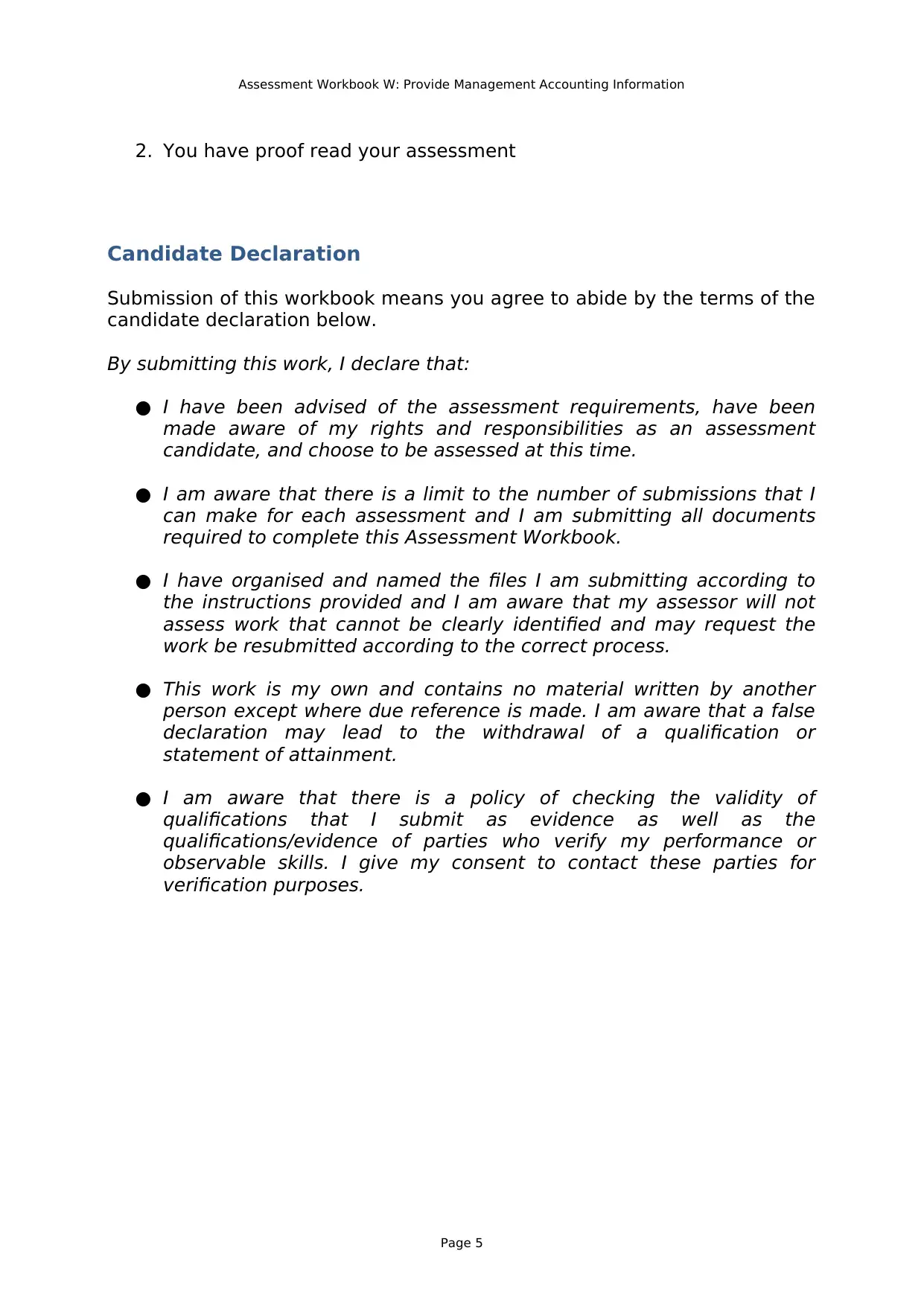
Assessment Workbook W: Provide Management Accounting Information
2. You have proof read your assessment
Candidate Declaration
Submission of this workbook means you agree to abide by the terms of the
candidate declaration below.
By submitting this work, I declare that:
● I have been advised of the assessment requirements, have been
made aware of my rights and responsibilities as an assessment
candidate, and choose to be assessed at this time.
● I am aware that there is a limit to the number of submissions that I
can make for each assessment and I am submitting all documents
required to complete this Assessment Workbook.
● I have organised and named the files I am submitting according to
the instructions provided and I am aware that my assessor will not
assess work that cannot be clearly identified and may request the
work be resubmitted according to the correct process.
● This work is my own and contains no material written by another
person except where due reference is made. I am aware that a false
declaration may lead to the withdrawal of a qualification or
statement of attainment.
● I am aware that there is a policy of checking the validity of
qualifications that I submit as evidence as well as the
qualifications/evidence of parties who verify my performance or
observable skills. I give my consent to contact these parties for
verification purposes.
Page 5
2. You have proof read your assessment
Candidate Declaration
Submission of this workbook means you agree to abide by the terms of the
candidate declaration below.
By submitting this work, I declare that:
● I have been advised of the assessment requirements, have been
made aware of my rights and responsibilities as an assessment
candidate, and choose to be assessed at this time.
● I am aware that there is a limit to the number of submissions that I
can make for each assessment and I am submitting all documents
required to complete this Assessment Workbook.
● I have organised and named the files I am submitting according to
the instructions provided and I am aware that my assessor will not
assess work that cannot be clearly identified and may request the
work be resubmitted according to the correct process.
● This work is my own and contains no material written by another
person except where due reference is made. I am aware that a false
declaration may lead to the withdrawal of a qualification or
statement of attainment.
● I am aware that there is a policy of checking the validity of
qualifications that I submit as evidence as well as the
qualifications/evidence of parties who verify my performance or
observable skills. I give my consent to contact these parties for
verification purposes.
Page 5
⊘ This is a preview!⊘
Do you want full access?
Subscribe today to unlock all pages.

Trusted by 1+ million students worldwide
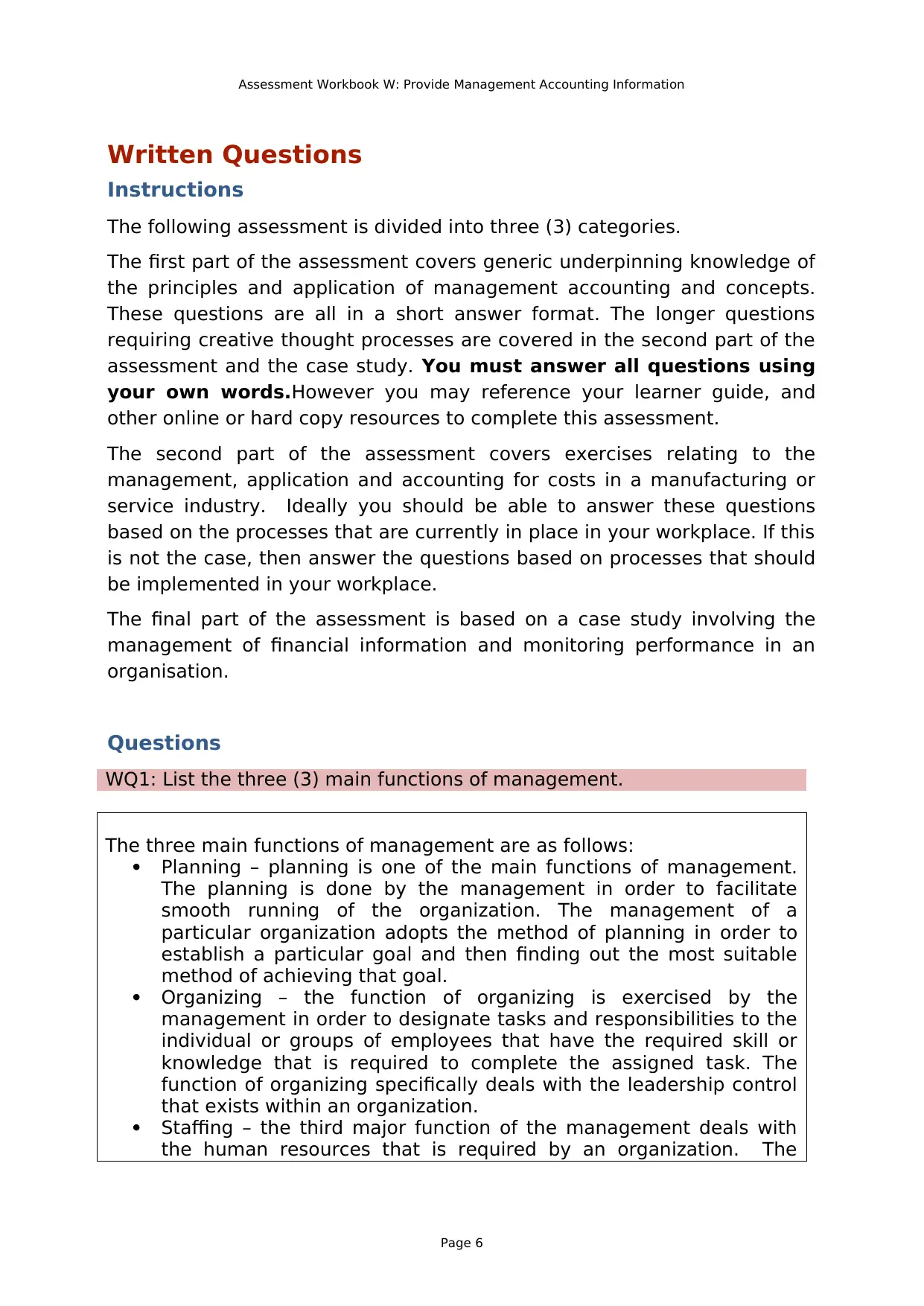
Assessment Workbook W: Provide Management Accounting Information
Written Questions
Instructions
The following assessment is divided into three (3) categories.
The first part of the assessment covers generic underpinning knowledge of
the principles and application of management accounting and concepts.
These questions are all in a short answer format. The longer questions
requiring creative thought processes are covered in the second part of the
assessment and the case study. You must answer all questions using
your own words.However you may reference your learner guide, and
other online or hard copy resources to complete this assessment.
The second part of the assessment covers exercises relating to the
management, application and accounting for costs in a manufacturing or
service industry. Ideally you should be able to answer these questions
based on the processes that are currently in place in your workplace. If this
is not the case, then answer the questions based on processes that should
be implemented in your workplace.
The final part of the assessment is based on a case study involving the
management of financial information and monitoring performance in an
organisation.
Questions
WQ1: List the three (3) main functions of management.
The three main functions of management are as follows:
Planning – planning is one of the main functions of management.
The planning is done by the management in order to facilitate
smooth running of the organization. The management of a
particular organization adopts the method of planning in order to
establish a particular goal and then finding out the most suitable
method of achieving that goal.
Organizing – the function of organizing is exercised by the
management in order to designate tasks and responsibilities to the
individual or groups of employees that have the required skill or
knowledge that is required to complete the assigned task. The
function of organizing specifically deals with the leadership control
that exists within an organization.
Staffing – the third major function of the management deals with
the human resources that is required by an organization. The
Page 6
Written Questions
Instructions
The following assessment is divided into three (3) categories.
The first part of the assessment covers generic underpinning knowledge of
the principles and application of management accounting and concepts.
These questions are all in a short answer format. The longer questions
requiring creative thought processes are covered in the second part of the
assessment and the case study. You must answer all questions using
your own words.However you may reference your learner guide, and
other online or hard copy resources to complete this assessment.
The second part of the assessment covers exercises relating to the
management, application and accounting for costs in a manufacturing or
service industry. Ideally you should be able to answer these questions
based on the processes that are currently in place in your workplace. If this
is not the case, then answer the questions based on processes that should
be implemented in your workplace.
The final part of the assessment is based on a case study involving the
management of financial information and monitoring performance in an
organisation.
Questions
WQ1: List the three (3) main functions of management.
The three main functions of management are as follows:
Planning – planning is one of the main functions of management.
The planning is done by the management in order to facilitate
smooth running of the organization. The management of a
particular organization adopts the method of planning in order to
establish a particular goal and then finding out the most suitable
method of achieving that goal.
Organizing – the function of organizing is exercised by the
management in order to designate tasks and responsibilities to the
individual or groups of employees that have the required skill or
knowledge that is required to complete the assigned task. The
function of organizing specifically deals with the leadership control
that exists within an organization.
Staffing – the third major function of the management deals with
the human resources that is required by an organization. The
Page 6
Paraphrase This Document
Need a fresh take? Get an instant paraphrase of this document with our AI Paraphraser
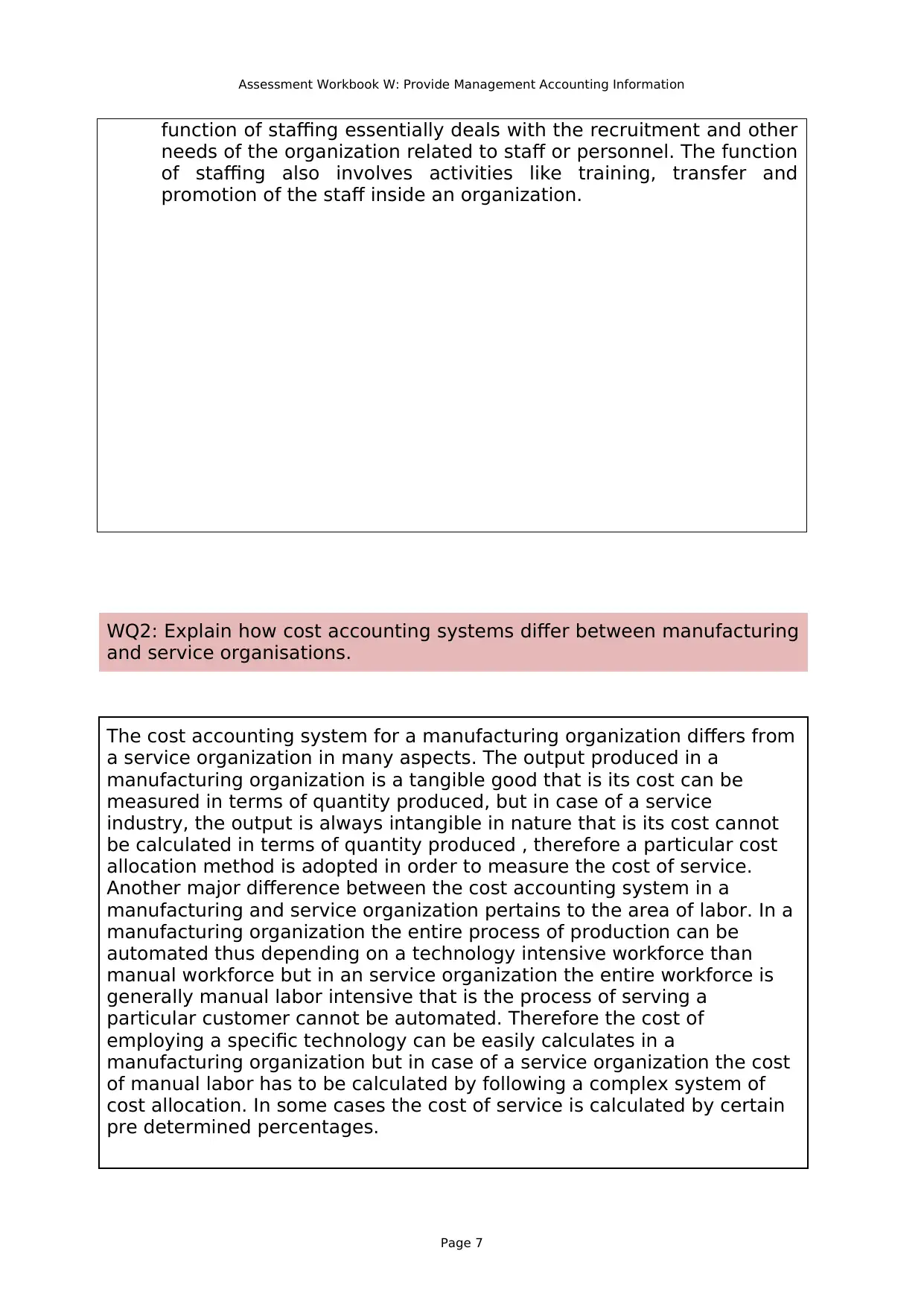
Assessment Workbook W: Provide Management Accounting Information
function of staffing essentially deals with the recruitment and other
needs of the organization related to staff or personnel. The function
of staffing also involves activities like training, transfer and
promotion of the staff inside an organization.
WQ2: Explain how cost accounting systems differ between manufacturing
and service organisations.
The cost accounting system for a manufacturing organization differs from
a service organization in many aspects. The output produced in a
manufacturing organization is a tangible good that is its cost can be
measured in terms of quantity produced, but in case of a service
industry, the output is always intangible in nature that is its cost cannot
be calculated in terms of quantity produced , therefore a particular cost
allocation method is adopted in order to measure the cost of service.
Another major difference between the cost accounting system in a
manufacturing and service organization pertains to the area of labor. In a
manufacturing organization the entire process of production can be
automated thus depending on a technology intensive workforce than
manual workforce but in an service organization the entire workforce is
generally manual labor intensive that is the process of serving a
particular customer cannot be automated. Therefore the cost of
employing a specific technology can be easily calculates in a
manufacturing organization but in case of a service organization the cost
of manual labor has to be calculated by following a complex system of
cost allocation. In some cases the cost of service is calculated by certain
pre determined percentages.
Page 7
function of staffing essentially deals with the recruitment and other
needs of the organization related to staff or personnel. The function
of staffing also involves activities like training, transfer and
promotion of the staff inside an organization.
WQ2: Explain how cost accounting systems differ between manufacturing
and service organisations.
The cost accounting system for a manufacturing organization differs from
a service organization in many aspects. The output produced in a
manufacturing organization is a tangible good that is its cost can be
measured in terms of quantity produced, but in case of a service
industry, the output is always intangible in nature that is its cost cannot
be calculated in terms of quantity produced , therefore a particular cost
allocation method is adopted in order to measure the cost of service.
Another major difference between the cost accounting system in a
manufacturing and service organization pertains to the area of labor. In a
manufacturing organization the entire process of production can be
automated thus depending on a technology intensive workforce than
manual workforce but in an service organization the entire workforce is
generally manual labor intensive that is the process of serving a
particular customer cannot be automated. Therefore the cost of
employing a specific technology can be easily calculates in a
manufacturing organization but in case of a service organization the cost
of manual labor has to be calculated by following a complex system of
cost allocation. In some cases the cost of service is calculated by certain
pre determined percentages.
Page 7
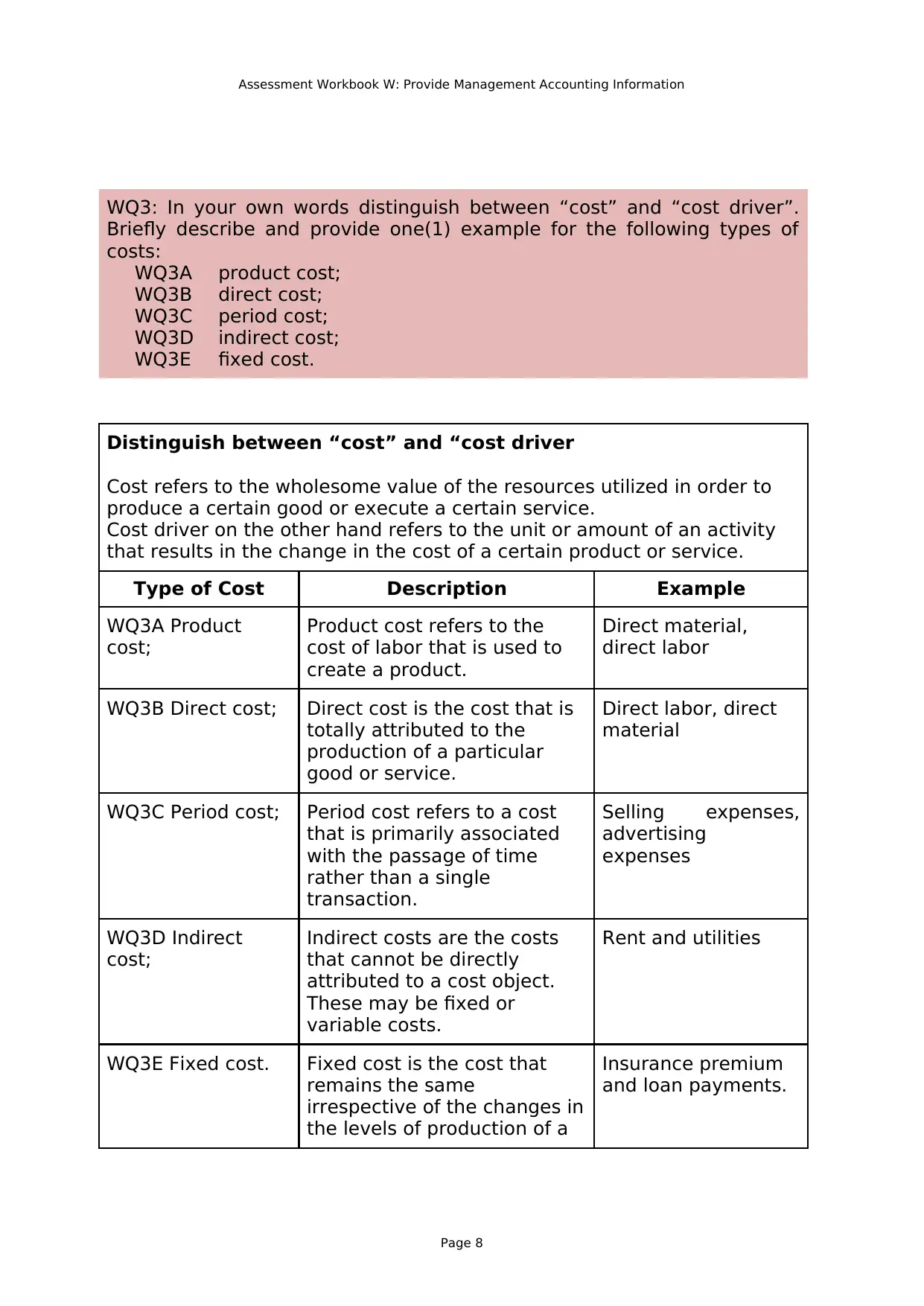
Assessment Workbook W: Provide Management Accounting Information
WQ3: In your own words distinguish between “cost” and “cost driver”.
Briefly describe and provide one(1) example for the following types of
costs:
WQ3A product cost;
WQ3B direct cost;
WQ3C period cost;
WQ3D indirect cost;
WQ3E fixed cost.
Distinguish between “cost” and “cost driver
Cost refers to the wholesome value of the resources utilized in order to
produce a certain good or execute a certain service.
Cost driver on the other hand refers to the unit or amount of an activity
that results in the change in the cost of a certain product or service.
Type of Cost Description Example
WQ3A Product
cost;
Product cost refers to the
cost of labor that is used to
create a product.
Direct material,
direct labor
WQ3B Direct cost; Direct cost is the cost that is
totally attributed to the
production of a particular
good or service.
Direct labor, direct
material
WQ3C Period cost; Period cost refers to a cost
that is primarily associated
with the passage of time
rather than a single
transaction.
Selling expenses,
advertising
expenses
WQ3D Indirect
cost;
Indirect costs are the costs
that cannot be directly
attributed to a cost object.
These may be fixed or
variable costs.
Rent and utilities
WQ3E Fixed cost. Fixed cost is the cost that
remains the same
irrespective of the changes in
the levels of production of a
Insurance premium
and loan payments.
Page 8
WQ3: In your own words distinguish between “cost” and “cost driver”.
Briefly describe and provide one(1) example for the following types of
costs:
WQ3A product cost;
WQ3B direct cost;
WQ3C period cost;
WQ3D indirect cost;
WQ3E fixed cost.
Distinguish between “cost” and “cost driver
Cost refers to the wholesome value of the resources utilized in order to
produce a certain good or execute a certain service.
Cost driver on the other hand refers to the unit or amount of an activity
that results in the change in the cost of a certain product or service.
Type of Cost Description Example
WQ3A Product
cost;
Product cost refers to the
cost of labor that is used to
create a product.
Direct material,
direct labor
WQ3B Direct cost; Direct cost is the cost that is
totally attributed to the
production of a particular
good or service.
Direct labor, direct
material
WQ3C Period cost; Period cost refers to a cost
that is primarily associated
with the passage of time
rather than a single
transaction.
Selling expenses,
advertising
expenses
WQ3D Indirect
cost;
Indirect costs are the costs
that cannot be directly
attributed to a cost object.
These may be fixed or
variable costs.
Rent and utilities
WQ3E Fixed cost. Fixed cost is the cost that
remains the same
irrespective of the changes in
the levels of production of a
Insurance premium
and loan payments.
Page 8
⊘ This is a preview!⊘
Do you want full access?
Subscribe today to unlock all pages.

Trusted by 1+ million students worldwide
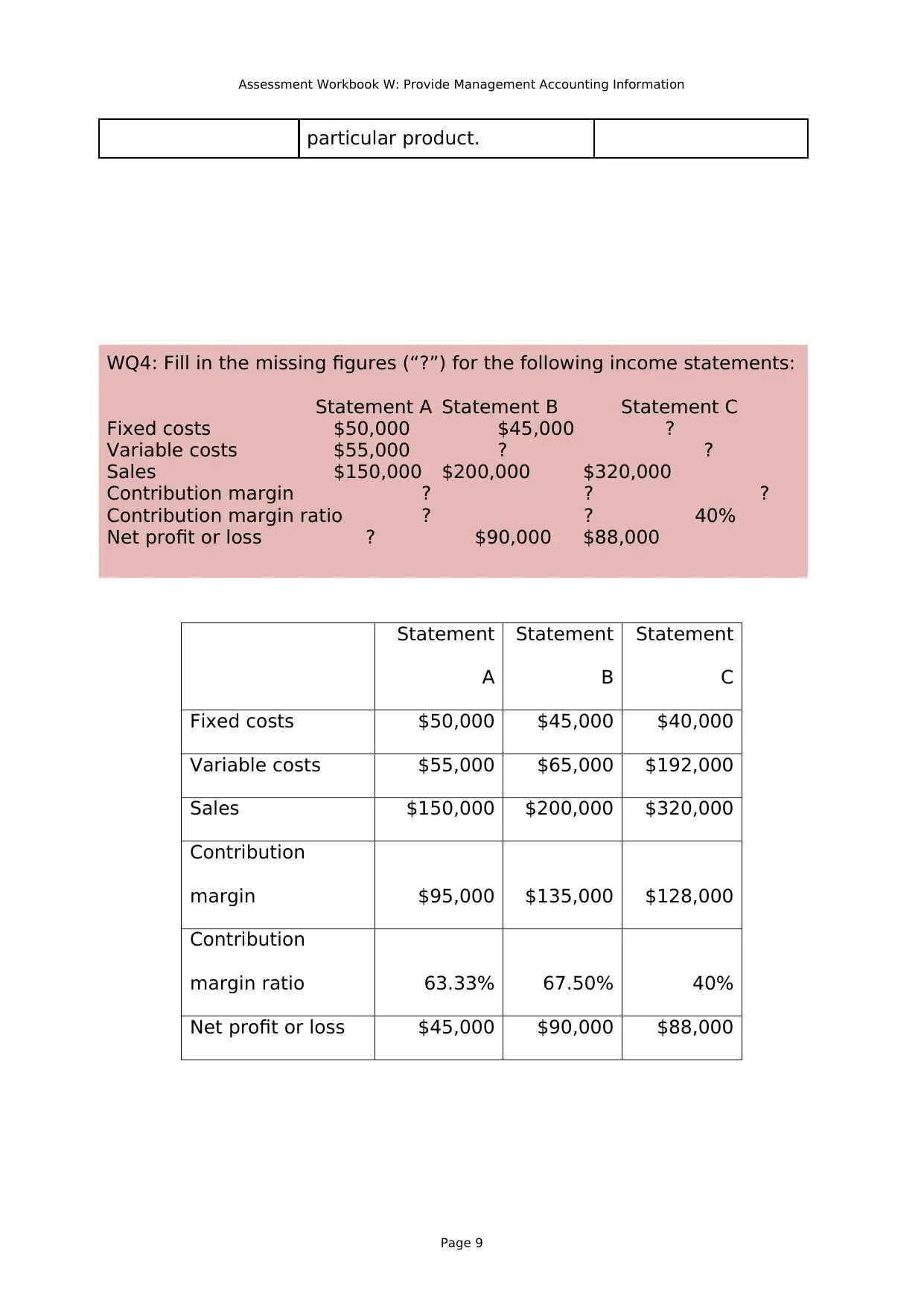
Assessment Workbook W: Provide Management Accounting Information
particular product.
WQ4: Fill in the missing figures (“?”) for the following income statements:
Statement A Statement B Statement C
Fixed costs $50,000 $45,000 ?
Variable costs $55,000 ? ?
Sales $150,000 $200,000 $320,000
Contribution margin ? ? ?
Contribution margin ratio ? ? 40%
Net profit or loss ? $90,000 $88,000
Statement
A
Statement
B
Statement
C
Fixed costs $50,000 $45,000 $40,000
Variable costs $55,000 $65,000 $192,000
Sales $150,000 $200,000 $320,000
Contribution
margin $95,000 $135,000 $128,000
Contribution
margin ratio 63.33% 67.50% 40%
Net profit or loss $45,000 $90,000 $88,000
Page 9
particular product.
WQ4: Fill in the missing figures (“?”) for the following income statements:
Statement A Statement B Statement C
Fixed costs $50,000 $45,000 ?
Variable costs $55,000 ? ?
Sales $150,000 $200,000 $320,000
Contribution margin ? ? ?
Contribution margin ratio ? ? 40%
Net profit or loss ? $90,000 $88,000
Statement
A
Statement
B
Statement
C
Fixed costs $50,000 $45,000 $40,000
Variable costs $55,000 $65,000 $192,000
Sales $150,000 $200,000 $320,000
Contribution
margin $95,000 $135,000 $128,000
Contribution
margin ratio 63.33% 67.50% 40%
Net profit or loss $45,000 $90,000 $88,000
Page 9
Paraphrase This Document
Need a fresh take? Get an instant paraphrase of this document with our AI Paraphraser
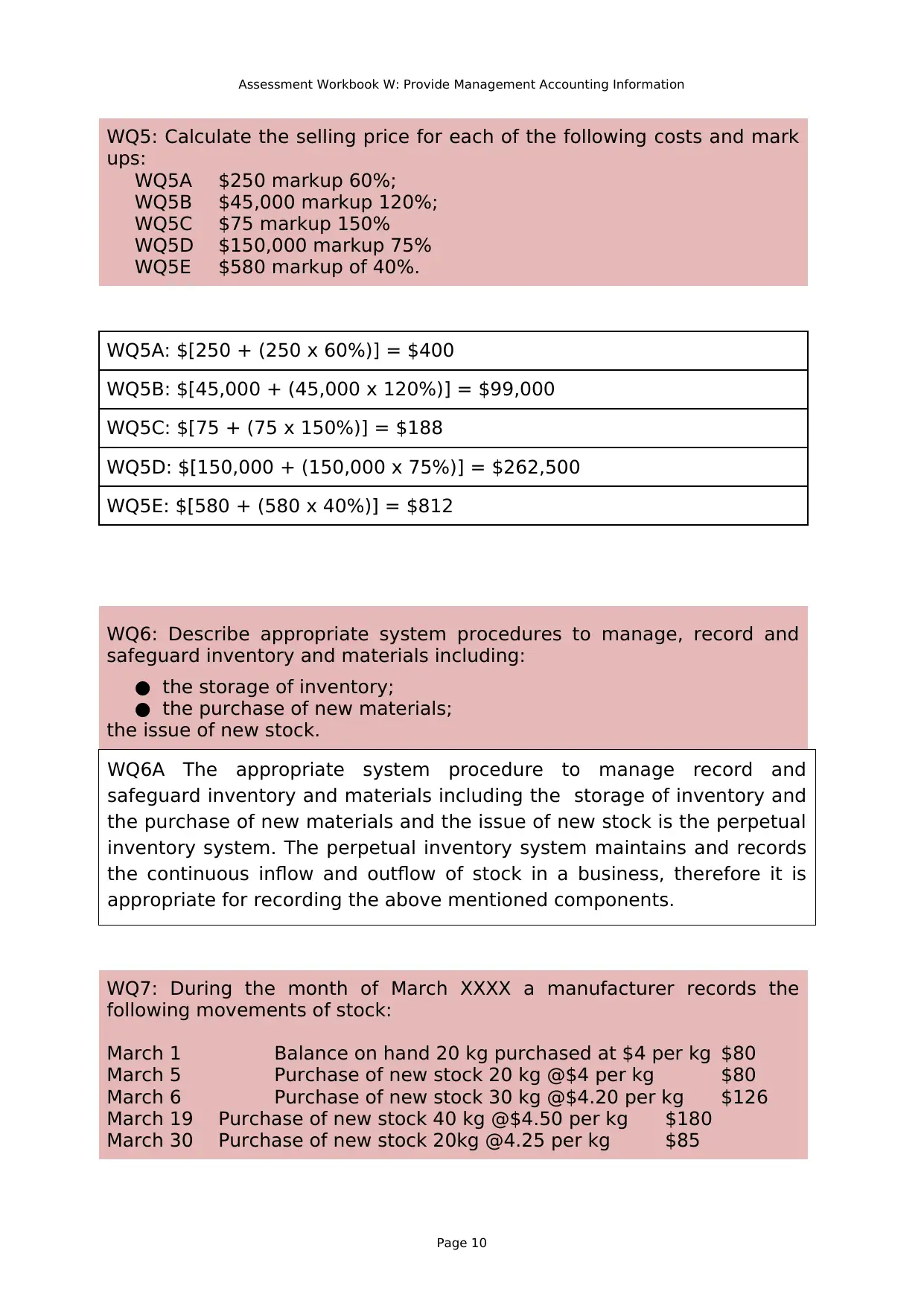
Assessment Workbook W: Provide Management Accounting Information
WQ5: Calculate the selling price for each of the following costs and mark
ups:
WQ5A $250 markup 60%;
WQ5B $45,000 markup 120%;
WQ5C $75 markup 150%
WQ5D $150,000 markup 75%
WQ5E $580 markup of 40%.
WQ5A: $[250 + (250 x 60%)] = $400
WQ5B: $[45,000 + (45,000 x 120%)] = $99,000
WQ5C: $[75 + (75 x 150%)] = $188
WQ5D: $[150,000 + (150,000 x 75%)] = $262,500
WQ5E: $[580 + (580 x 40%)] = $812
WQ6: Describe appropriate system procedures to manage, record and
safeguard inventory and materials including:
● the storage of inventory;
● the purchase of new materials;
the issue of new stock.
WQ6A The appropriate system procedure to manage record and
safeguard inventory and materials including the storage of inventory and
the purchase of new materials and the issue of new stock is the perpetual
inventory system. The perpetual inventory system maintains and records
the continuous inflow and outflow of stock in a business, therefore it is
appropriate for recording the above mentioned components.
WQ7: During the month of March XXXX a manufacturer records the
following movements of stock:
March 1 Balance on hand 20 kg purchased at $4 per kg $80
March 5 Purchase of new stock 20 kg @$4 per kg $80
March 6 Purchase of new stock 30 kg @$4.20 per kg $126
March 19 Purchase of new stock 40 kg @$4.50 per kg $180
March 30 Purchase of new stock 20kg @4.25 per kg $85
Page 10
WQ5: Calculate the selling price for each of the following costs and mark
ups:
WQ5A $250 markup 60%;
WQ5B $45,000 markup 120%;
WQ5C $75 markup 150%
WQ5D $150,000 markup 75%
WQ5E $580 markup of 40%.
WQ5A: $[250 + (250 x 60%)] = $400
WQ5B: $[45,000 + (45,000 x 120%)] = $99,000
WQ5C: $[75 + (75 x 150%)] = $188
WQ5D: $[150,000 + (150,000 x 75%)] = $262,500
WQ5E: $[580 + (580 x 40%)] = $812
WQ6: Describe appropriate system procedures to manage, record and
safeguard inventory and materials including:
● the storage of inventory;
● the purchase of new materials;
the issue of new stock.
WQ6A The appropriate system procedure to manage record and
safeguard inventory and materials including the storage of inventory and
the purchase of new materials and the issue of new stock is the perpetual
inventory system. The perpetual inventory system maintains and records
the continuous inflow and outflow of stock in a business, therefore it is
appropriate for recording the above mentioned components.
WQ7: During the month of March XXXX a manufacturer records the
following movements of stock:
March 1 Balance on hand 20 kg purchased at $4 per kg $80
March 5 Purchase of new stock 20 kg @$4 per kg $80
March 6 Purchase of new stock 30 kg @$4.20 per kg $126
March 19 Purchase of new stock 40 kg @$4.50 per kg $180
March 30 Purchase of new stock 20kg @4.25 per kg $85
Page 10
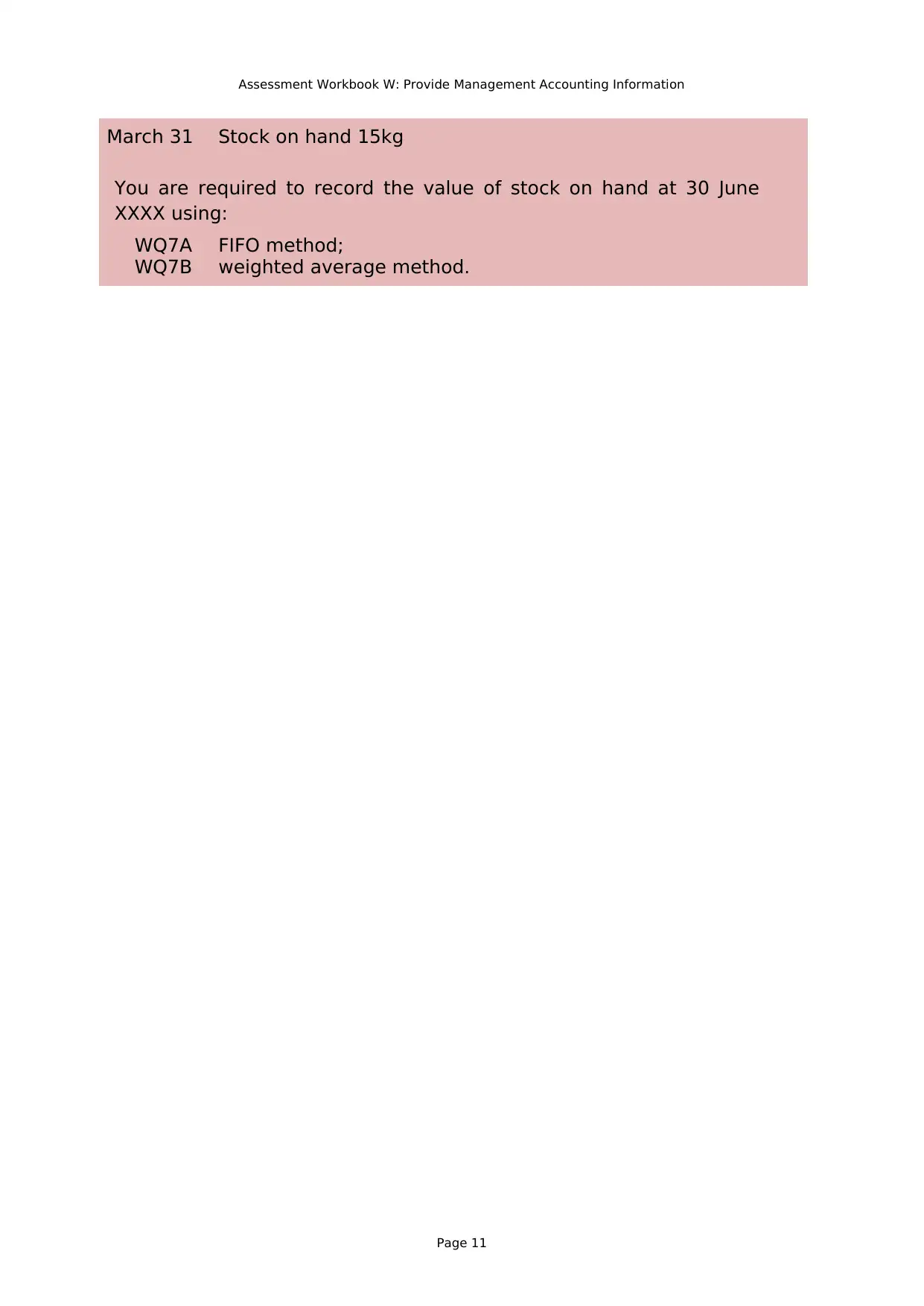
Assessment Workbook W: Provide Management Accounting Information
March 31 Stock on hand 15kg
You are required to record the value of stock on hand at 30 June
XXXX using:
WQ7A FIFO method;
WQ7B weighted average method.
Page 11
March 31 Stock on hand 15kg
You are required to record the value of stock on hand at 30 June
XXXX using:
WQ7A FIFO method;
WQ7B weighted average method.
Page 11
⊘ This is a preview!⊘
Do you want full access?
Subscribe today to unlock all pages.

Trusted by 1+ million students worldwide
1 out of 44
Related Documents
Your All-in-One AI-Powered Toolkit for Academic Success.
+13062052269
info@desklib.com
Available 24*7 on WhatsApp / Email
![[object Object]](/_next/static/media/star-bottom.7253800d.svg)
Unlock your academic potential
Copyright © 2020–2025 A2Z Services. All Rights Reserved. Developed and managed by ZUCOL.





